
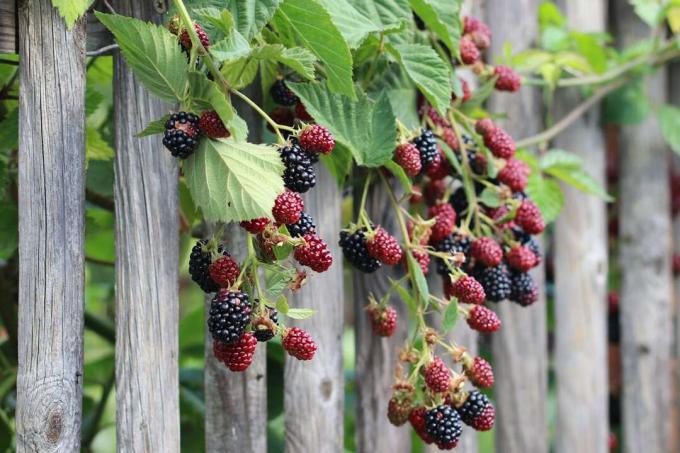
Table of contents
- plant cutting
- Training cut for trellis
- Instructions for a maintenance cut
- Instructions for a column cut
- summer cut
- radical cut
- A must: suitable cutting tools
The knowledgeable gardener cuts his blackberries every year. Reward for the effort: large and sweet fruits. Pruning follows clear instructions, as growth characteristics leave little room for maneuver in terms of pruning and timing.
plant cutting
Blackberries are ideally planted in spring, around March or April. The first pruning takes place immediately after planting. All tendrils are cut back to 30 to 40 cm, just above a leaf or shoot bud. Buds close to the ground should be covered with soil about 5 cm deep. Later in the spring the best rods are selected and the rest removed close to the ground. 2-3 canes should remain on fast-growing varieties and 5 to 10 canes on slow-growing varieties.
Training cut for trellis
At the same time, two-year-old canes that bear fruit in the current year and newly sprouted canes that will only bear fruit in the following year are found on blackberry plants. When blending, both types must be clearly distinguished. Otherwise young fruit shoots could be accidentally removed or useless harvested canes left standing. Training on a trellis helps to keep track of things because the rods are attached to it alternately.

- Set up a wire trellis before planting
- 6 m wide for fast-growing varieties
- for less expansive varieties 3-4 m wide
- stretch three wires at a height of 50, 100 and 150 cm
- Plant the plant in the middle of the trellis
- Tie all selected rods horizontally or in a fan shape
- only use one side of the wire trellis for this
- in the following year tie the new rods on the other side of the trellis
- this way, this year's and two-year-old rods are clearly separated spatially
- the binding made subsequent mixing impossible
Tip:
Before planting, find out if the blackberry variety you choose will produce suckers. The thorny varieties in particular are known for this. If this is the case, you should definitely set up a root barrier about 30 cm deep for the shallow roots. The easiest way to do this is to line the planting pit with pond liner.
Instructions for a maintenance cut
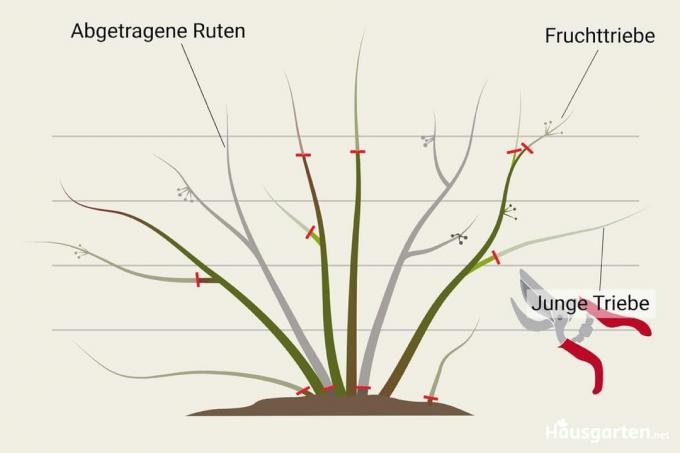
The worn rods must be cut annually and detached from the trellis wire. At the same time, new fruit canes must be cared for and tied with suitable cutting measures. In a very mild region, pruning can be done in the fall after harvest. Unless the rods have been arranged alternately on a trellis, they are easy to distinguish at this point. In a rather harsh region you should definitely wait until February or March before pruning. The blackberry sprout happily after pruning. It is not certain whether the new shoots will be able to harden well until winter.
- Wait for an ideal day. The sky should be overcast and the temperature should be above freezing.
- Cut back all worn and dead canes from the previous year close to the ground.
- Cut back side shoots on last year's tendrils, which form the new fruit shoots, to two or three buds.
Tip:
When pruning blackberries, you should always place the scissors about ½ to 1 cm above a bud that is pointing outwards. A bud is easy to spot as it looks like a slight bulge on the shoot.
Instructions for a column cut
In a small garden, training on a trellis is not possible for reasons of space. An upright columnar shape, on the other hand, is easy to achieve. It even allows planting in a bucket on the balcony. However, mainly weak-growing, thornless varieties are suitable for this type of training.
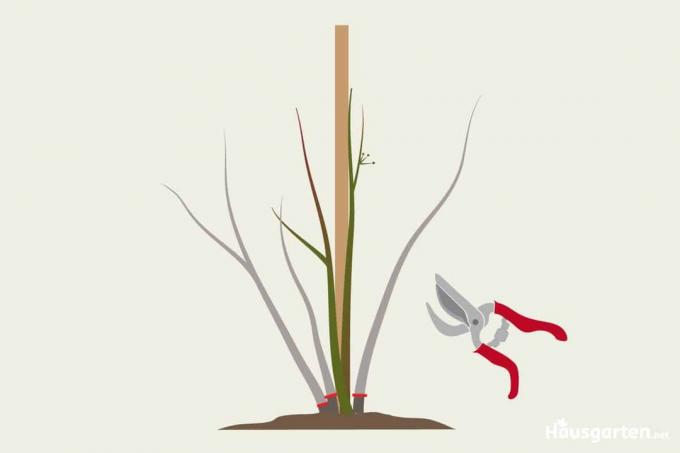
Here are the instructions for the column cut:
- After planting, tie the two strongest shoots to a support stake. Since blackberry tendrils are not very heavy, 1-2 strong, long bamboo sticks, which are inserted deep into the ground, are sufficient.
- Cut off the remaining shoots at ground level.
- As the year progresses, guide the long-grown shoots up the support post.
- Perform a maintenance pruning every February.
- Cut off worn-out shoots.
- Secure one or two new rods to the support stake and cut the rest off at the base.
- Cut back side shoots to 1-2 buds.
- Shorten the main shoots to the desired length.
Tip:
If possible, cut back harvested canes immediately after harvest. Leave a 10-15 long stump while doing this. Practice has shown that new tendrils sprout from sleeping eyes in spring.
summer cut
If you only cut fast-growing varieties once a year, you won't get the best out of the berry bushes. In addition, these tend to form a confusing undergrowth in the course of the summer. The reason for this is the numerous stinging shoots that form on the side of the main shoots. They do not flower or bear fruit, and they compete with the fruit shoots for water and nutrients. If the rods are not tied alternately, the stingy shoots will also cast shadows on fruit shoots with their lush foliage. The fruits can then not ripen optimally or even go moldy, since rain moisture cannot evaporate in a timely manner.
- do a summer pruning in July
- Select and tie up suitable rods for this year
- remove excess tendrils
- Cut back side shoots (stingy shoots) to 1-2 buds
radical cut
If a blackberry plant is cared for annually according to instructions, there will be no need for radical pruning throughout its lifespan. If the cutting has been omitted, a closer look can correct what has been missed. It's different after years of neglect. If you can no longer distinguish between this year's and old rods in the tangle of rods, you should cut off all rods. After the new shoots, the regular, orderly pruning care can then be resumed. Of course, such a radical cut is associated with a crop failure in the cutting year.
A must: suitable cutting tools
It's not just pruning mistakes that can endanger healthy growth and a bountiful harvest. If you cut your blackberries with unclean or blunt scissors, you will produce contaminated or frayed interfaces. This makes the blackberries particularly susceptible to diseases and pests. Before each cut, the blades must therefore be sharpened and disinfected with a suitable agent, such as alcohol.
Tip:
A weak young cane that needs to be cut off in the spring is too good for the compost heap. If the shoot is cut cleanly and smoothly into pieces about 30 cm long and these are planted in loose, nutrient-rich soil, new blackberry bushes will grow from them in no time.
 garden editorial
garden editorial I write about everything that interests me in my garden.
Learn more about pruning

Eucalyptus dried up: cut back now?
When a eucalyptus dries up, some owners immediately think of cutting it back. Because they want to see fresh green bud quickly. The chances of that happening may be good. But one thing must not be left out: research into the causes! Otherwise a new cycle of drying up and cutting begins.

cutting snowball | 13 tips for pruning
When it comes to snowballs (Viburnum), the opinions of numerous hobby gardeners differ when it comes to cutting. Main reason against pruning: Destruction of the natural appearance by pruning. Find out now when it is unavoidable and which tips should be heeded.

Cutting sage: 6 tips for cutting back
Cutting measures and their ideal time depend on the species of sage plants, because they have differentiated ways of life. There are woody and herbaceous representatives that require different attention. In order to carry out the measures, a basic set of tools is helpful.

Pruning hydrangeas: when is the right time?
Hydrangeas are a real beauty because of their flowers. In the long term, however, the flowering power is only maintained if regular pruning takes place. Because cutting off withered or dried plant parts offers protection. The following guide shows when this measure should be taken.
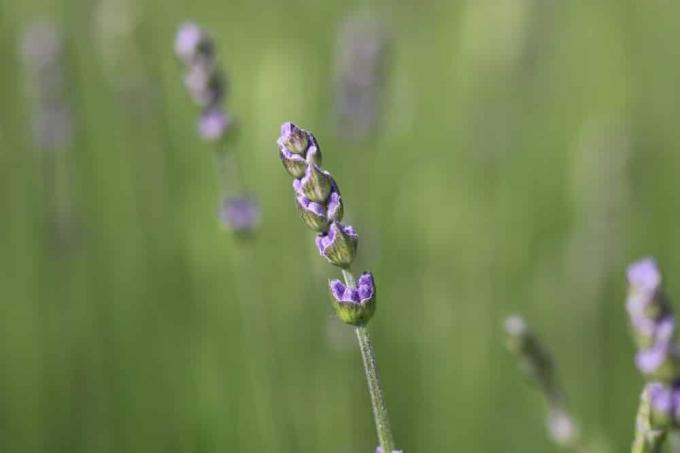
Cutting Lavender | When is the best time?
Lavender is a popular perennial, but difficult to cut. Without regular pruning, the shrub becomes lignified and less robust. Choosing the right time is important for pruning. When to cut depends on the use of the perennials.
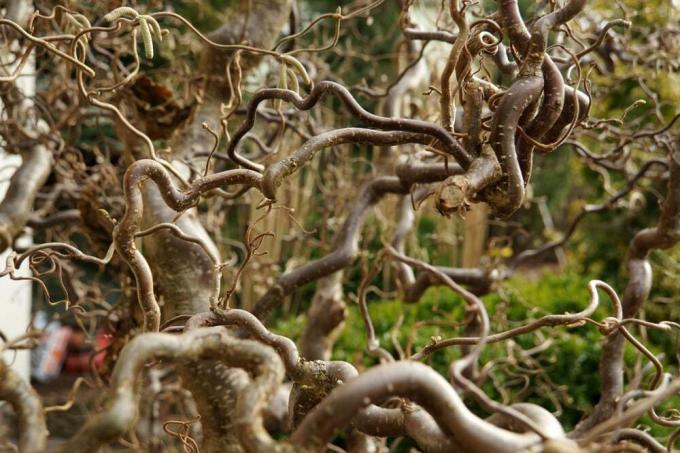
Cut corkscrew hazelnut | Rejuvenate corkscrew hazel properly
The corkscrew hazel does not necessarily have to be cut regularly, but the use of pruning shears and the like can make sense. You can read here when and how to best cut the corkscrew hazel!
